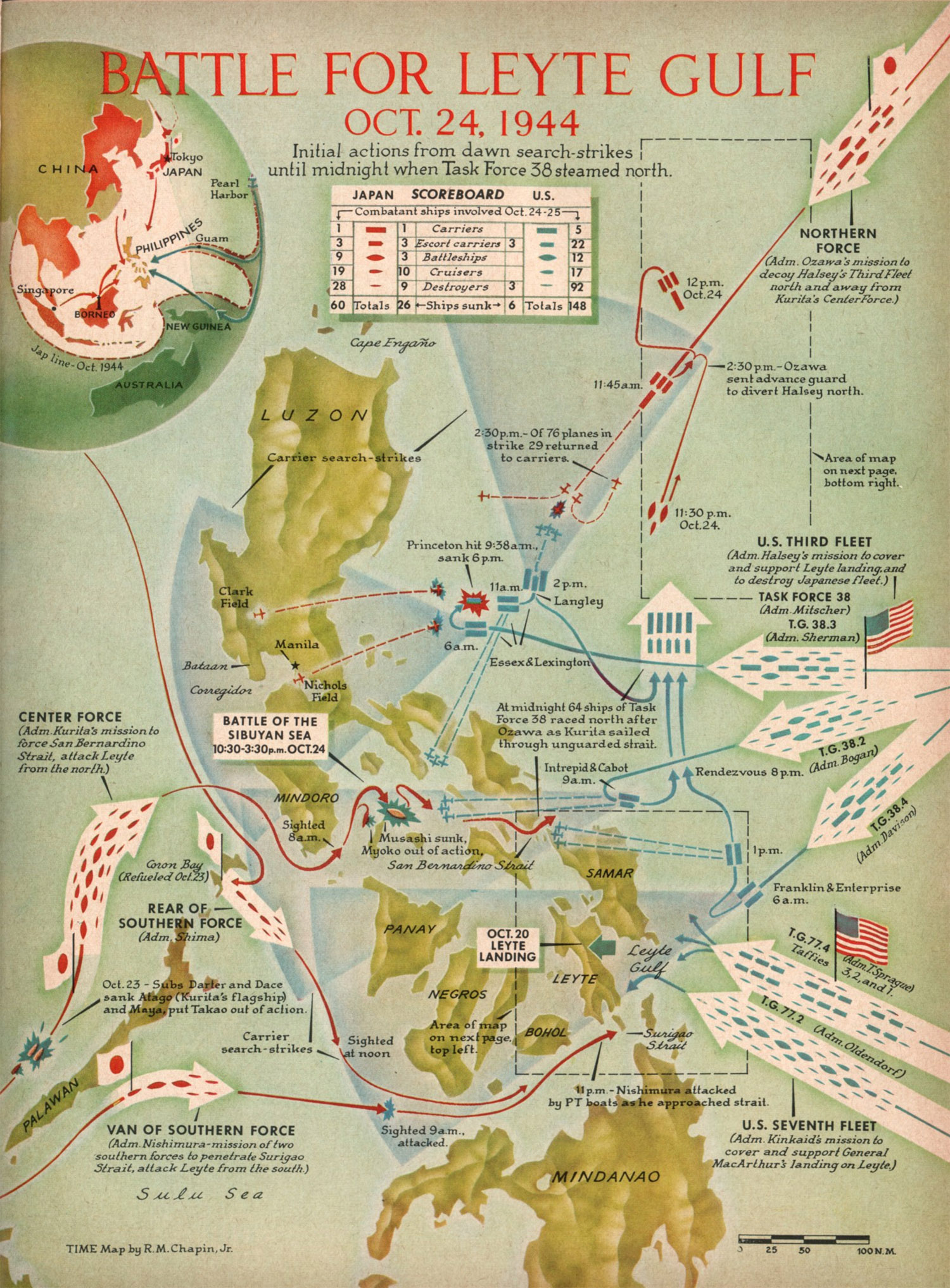In 1959, reflecting on the Battle of Leyte Gulf from a distance of 15 years, TIME declared that the World War II engagement — between the Japanese navy and U.S. troops on and around the island of Leyte, which the U.S. had taken a few days before — was “the greatest battle in the history of naval warfare.” (The map above is from that issue; roll over to zoom on a desktop or click if you’re viewing on mobile.)
The battle began on Oct. 23, 1944, when Vice Admiral Takeo Kurita of Japan led a fleet into the region and was flushed out by U.S. submarines. Over the course of three days of heavy fighting, the U.S. troops crippled the Japanese navy — and in the process made clear that old-fashioned line-of-battle style naval warfare no longer made sense, ending a military tradition that had been in place for centuries.
The battle was also a crucial step in General Douglas MacArthur‘s making good on his famed 1942 “I shall return” promise to the Philippines. But the troops weren’t the only Americans there — TIME correspondents were also in the area, sending dispatches back to the office. In the magazine’s Oct. 30, 1944, letter from the publisher, TIME explained how the process worked:
Last Friday John Walker of TIME’S Battlefronts department handed his first dispatch from the Philippines to an Army short-wave broadcaster.
“American power came back to the Philippines today over the glass-smooth, grass-green waters of Leyte Gulf under a tropical sun coming through an ominous haze lit by yellow flashes and the blasting of guns,” that message began. “It was virtually perfect weather for the landings.”
Walker’s words flashed across 7,000 miles of ocean via U.S. Army Signal Corps circuits to San Francisco. And there the monitors of the Blue Network picked them up—recorded them—wrote them down—and wired them east by fast overland telegraph—to reach TIME’S editors in New York in less than an hour’s time…
“All landings seem to have come off well,” Walker reported. “The beach where I am was perforated by both mortar and artillery fire at landing. Two boats hit, one sunk. Casualties relatively light. Loyal Filipinos helping us from the first moment of landing.”
Walker went on to tell how General MacArthur got his first view of the Philippines—”a gun-rocked coast backed by rolling hills. He saw it from a cruiser standing in to shore an hour after the landings, sitting placidly on the flag bridge puffing his pipe. . . .”
And when the General came ashore at Red Beach, TIME’S Bill Chickering, veteran of the Gilberts and the landing on Bougainville, was waiting on that “toughest beachhead” to report MacArthur’s arrival with President Osmeña:
“Both men seemed calm,” Chickering short-waved, “but MacArthur borrowed a canteen and his hand trembled as he held it to his lips. Watching his expression, there was no mistaking his elation. . . .
Read TIME’s full 1959 remembrance of the Battle of Leyte Gulf, here in the archives: Greatest & Last Battle of a Naval Era
More Must-Reads from TIME
- Cybersecurity Experts Are Sounding the Alarm on DOGE
- Meet the 2025 Women of the Year
- The Harsh Truth About Disability Inclusion
- Why Do More Young Adults Have Cancer?
- Colman Domingo Leads With Radical Love
- How to Get Better at Doing Things Alone
- Michelle Zauner Stares Down the Darkness
Write to Lily Rothman at lily.rothman@time.com
